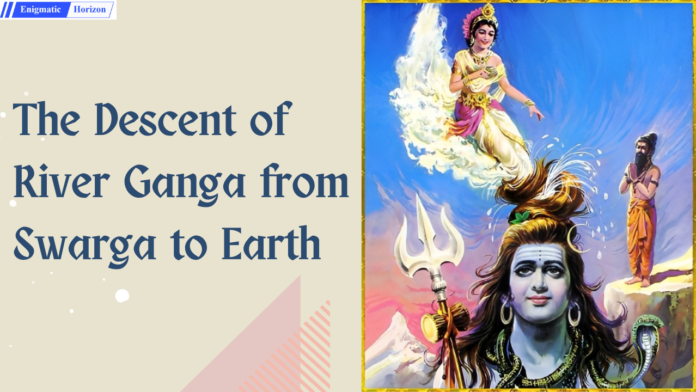Amlan Shekhar Baruah
The Ganga River is the holiest river in the world. The story of her descent from heaven to earth via Mahadeva Shiva’s head is described in various scriptures. Here we tell the story as depicted in the epic Ramayana. A young Bhagavaan Rama heard this tale from his teacher, Rishi Vishwamitra.
Once, there was a king of Ayodhya named Sagara. As they were torturing Mother Earth and killing her creatures, Lord Vishnu in the form of Sage Kapila reduced his 60,000 sons to ashes. Seeing that his sons had not returned after a long time, King Sagara sent his grandson Angshumaan to search for them. Then Angshumaan proceeded to look for his 60,000 uncles and finally reached the place where his uncles were reduced to ashes. On seeing their dead bodies, he was overwhelmed with extreme grief and wept. Then he searched for water in order to offer obsequial waters to the departed sons of the king, but could not find any fount of water. Then he saw Garuda, the king of all birds and the vehicle of Lord Vishnu. Garuda told Angshumaan that his uncles had to be killed for the good of the world. Additionally, it would be useless to pay them tribute with simple water oblations because they had been killed by the all-powerful Kapila. Only the River Ganga, the world purifier, would be able to lead them to Swarga (heaven).
Thus, Angshumaan returned to King Sagara and described everything to him. King Sagara tried for thousands of years to find a way to bring Ganga down to the earth, but could not until his death. Then, Angshumaan was made the king of Ayodhya, and he begot a great son named Dileepa. Assigning the kingdom to Dileepa, Angshumaan undertook a very stern ascesis for 32,000 years on a peak of the Himalayas for the purpose of the descent of the River Ganga to earth. But he also failed and died. Then Dileepa tried for thousands of years to find a way to bring Ganga to earth, but he failed as well and passed away after assigning the kingdom to his son, Bhageeratha. Unfortunately, Bhageeratha was childless. So, if he was unable to cause the descent of Ganga to earth, there would be no one else in his lineage to do it.
So, king Bhageeratha assigned his kingdom to his ministers and people and undertook severe ascesis by standing amidst the pancha agnis (5 fires), upraising his hands, eating food just once a month, and conquering all his senses. Seeing him continue this ascension for thousands of years, Lord Brahma became very pleased and granted him a boon. Bhageeratha wished that the ashes of the 60,000 sons of Sagara be drenched with the waters of the Ganga and depart to heaven eternally. He also wished for children so that his lineage would not die. Lord Brahma promised to fulfil all his wishes and also said that the earth would not be able to endure the downfall of the River Ganga and that none other than Lord Shiva was capable of sustaining the force of the Ganga. Then, Lord Brahma left, and King Bhageeratha practised ascesis by standing on the tip of his toe and praying to Mahadeva Shiva. On the completion of one year, Lord Shiva was pleased and presented himself to the king. He told him that he would sustain River Ganga with his head.
Thereafter, Ganga plunged from the sky onto the auspicious head of Mahadeva Shiva. Ganga was filled with egotism and wanted to enter Paataala (the lowest netherworld) by crashing through the earth and dragging Shiva along by her force. Shiva became furious and locked her up in the tufts of his hair. After several years, Bhageeratha again practised ascesis for the sake of Ganga’s descent to earth. Pleased with his ascesis, Mahadeva Shiva released Ganga into Bindu Lake in the Himalayas. Out of the lake, seven streams of Ganga emerged. Hlaadinee, Paavanee, and Nalinee flowed eastward, while Suchakshu, Seeta, and the great river Sindhu flowed westward. The 7th stream flowed towards the path of Bhageeratha’s chariot and followed it everywhere.
Then Bhageeratha led Ganga to the place where the ashes of Sagara’s sons were present. Ganga inundated that mound of ashes of Sagara’s sons, by which their sins were cleansed and they attained Swarga. While the waters of Ganga were inundating those ashes, Lord Brahma told king Bhageeratha that Ganga would become his daughter and be named “Bhaageerathee,” and that none of his ancestors could bring Ganga to earth and that only he could do it, which was an outstanding achievement. Then Lord Brahma told him to offer oblations to his forefathers with the waters of the Ganga and left. Thus, king Bhageeratha offered oblations of Ganga’s waters to Sagara’s sons and his other ancestors. Then he returned to his city and happily ruled his kingdom.
This story teaches us that we can achieve anything in life if we are righteous, selfless, and sincere in our duties and devotion to God. All the kings before Bhageeratha had virtuous children, while Bhageeratha was childless. Yet king Bhageeratha was the only one who could bring River Ganga to earth, due to which Lord Brahma granted him the boon that Ganga would become his daughter and be named “Bhaageerathee” after him. Thus, even if one is born imperfect or faces other unfortunate circumstances in their life, they can still achieve the best of things with goodness, virtue, hard work, devotion, and commitment.
